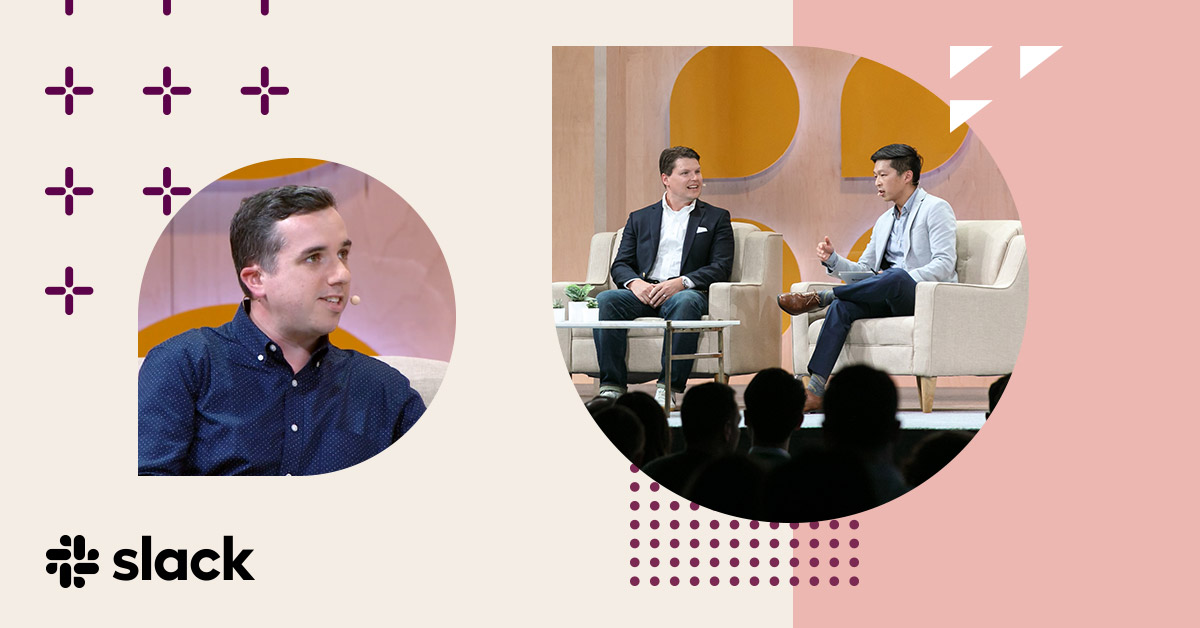How apps for Slack help IBM and Hearst get more from their tech stack - 5 minutes read
 How apps for Slack help IBM and Hearst get more from their tech stack
How apps for Slack help IBM and Hearst get more from their tech stack“It’s great to build a single application, but it’s better when you tie multiple applications together to deliver bigger business value,” said Kirk Pedersen, a senior IT leader at IBM, from the stage of our recent Frontiers conference, where business leaders joined Slack partners, customers and technologists to explore new ways of working together.
There are three different ways to unlock this kind of value from your tech stack using Slack:
Pedersen, along with Hearst Magazines’ product strategy director Michael Solomon, took the stage at Frontiers to share how they’re bringing the tools their teams use every day into Slack. Watch a video of their session above (which also includes a demo of Workflow Builder). Or, read on for the highlights.
IBM is one of the largest IT service companies in the world, and its use of Slack is novel for being so big. With around 165,000 employees actively on Slack, IBM has installed more than 3,000 off-the-shelf and custom apps into its over 10,000 Slack workspaces. “Our employees identify how to best use Slack,” said Pedersen, whose team interfaces with every business unit within IBM. “Part of that is apps.”
About a year and a half ago, Pedersen tasked the development team that originally brought Slack into IBM with identifying new opportunities for automation and orchestration. One of the team’s most successful results was an incident manager bot, which brings updates from tools such as PagerDuty and Statuspage into Slack.
The use of a bot in a real-time interface like Slack means IBM’s teams can troubleshoot support issues faster, reduce their mean time to resolution, and increase customer satisfaction in the process. “The goal is really to align multiple applications together and deliver it in-app, where the engineers are,” Pedersen said.
Slack is used organization-wide at Hearst, a publication empire that produces more than 2,500 pieces of content each day under brands like Cosmopolitan, ELLE and Esquire.
Data at Hearst has historically been difficult for publishing teams to access. If you work on the print side, your data is primarily sourced from infrequent, expensive focus groups that rarely yield actionable insights. On the other hand, folks in digital publishing are awash in data, and the volume makes pinpointing what you need difficult and time consuming. “Dashboards are where data goes to die,” said Solomon. “Surfacing data in Slack helps us solve that last-mile problem.”
To help everyone at Hearst surface the right data to the right people at the right time—and drive better editorial decisions—Solomon’s team developed a custom bot called Hans. It’s a bot of many talents, which include:
According to Solomon, Hans is used more than 1,000 times a day across the Hearst portfolio. Want to build your own custom data app for Slack? Solomon recommends determining a data wishlist, then leaning onthe Slack API documentation to build your first iteration.
If you have a software development team, you can build anything custom that you can dream up. But for most of us, saving a bit of time on routine tasks, like requests, reviews and approvals, shouldn’t require a dedicated lift from your tech team.
Our upcoming Workflow Builder offers a bridge between fully custom apps, which require deep programming knowledge, and off-the-shelf apps designed by others. Workflows can begin when someone joins a channel, clicks on an Actions button in a menu, or runsa slash command. From there, you can gather information in forms and send the results into either channels or DMs, however you see fit.
With Workflow Builder, you can do things like create a signup form for visiting other offices that contains your workgroup name (so they know where to put your temporary desk), your dietary preferences and the exact dates you’ll be around. Once a form is submitted, it can send the results into a private office operations channel, where the team can get to work welcoming you. You can build similar workflows for IT equipment requests, editorial pitches for a blog or podcast, or use a form to capture possible questions for an all-hands Q&A meeting with executives.
The best part? You can create these workflows inside of Slack itself with your mouse and keyboard, picking options and writing questions for forms. It’s coming soon, and Slack admins can sign up here to join the waitlist for the pilot program.
Source: Slackhq.com
Powered by NewsAPI.org
Keywords:
Application software • IBM • Hearst Communications • Application software • Application software • Leadership • IBM • Leadership • Partnership • Customer • Technology • Technology • Randy Pedersen • Hearst Communications • Michael Solomon (author) • Technology demonstration • Workflow • IBM • IBM • Application software • IBM • Application software • Charles J. Pedersen • Slack (software) • IBM • Automation • Management • Chatbot • Patch (computing) • Programming tool • Slack (software) • Chatbot • Real-time computing • User interface • Slack (software) • IBM • Technical support • Software project management • Customer satisfaction • Business process • Pedersen bicycle • Hearst Communications • Cosmopolitan (magazine) • Elle (magazine) • Esquire (magazine) • Hearst Communications • Printing • Focus group • Last mile (transportation) • Hearst Communications • Robot • Hearst Communications • Mobile app • Wish list • Application programming interface • Software development • Technology • Workflow • Construction • Mobile app • Computer programming • Knowledge • Workflow • Button (computing) • Runsa • Slashdot • Information • Document management system • Workflow • Blog • Podcast • Computer keyboard •